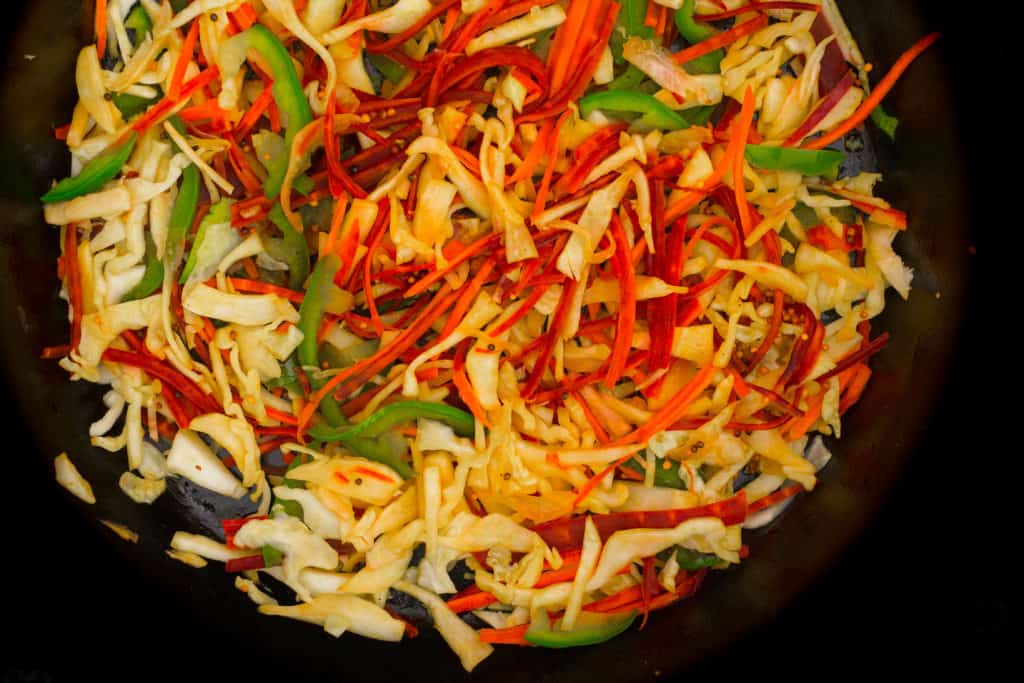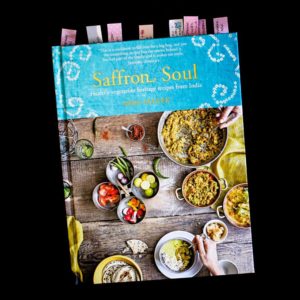Author Mira Manek looks back to her Gujarat roots, with inspiration from her mother and grandmother, to pen this volume of vegetarian recipes. The author's goal with Saffron Soul is to offer a fresh take on Indian food, diverting attention away from the rich and indulgent dishes we assume represent the cuisine as a whole. Mira's modern take on Indian cooking is a refreshing example of how any traditional fare has space for reinvention alongside conventional local recipes of a given region.
While the book is very health focussed and I am not, I always find value and inspiration in anyone who is clearly passionate with respect to the food they are writing about, and it's clear Mira is. Of the five items from the book I made, there wasn't one I wouldn't make again in future. Instructions are straightforward and easy to follow, and measurements are provided in both metric and imperial quantities.
The book is divided into six chapters of recipes, with a couple of preceding chapters covering key ingredients as well as pastes and garnishes (hello maple chillied seeds). Recipe chapters are organised logically. We start with breakfast and then anytime favourites, moving onto light meals and traditional thalis. Finally there are separate chapters for both spiced drinks and desserts.
Sambharo, a spiced salad of cabbage and carrot, is a fifteen minute affair (including prep time). For that reason, despite its intention as a side to complement a thali, it's a good lunchtime dish on its own. The seasoning is uncomplicated with just salt, turmeric, and mustard seeds, plus final squeeze of lime to balance the flavours. It's so simple that the salad ought not be as good as it is, but there you go; sometimes simplicity goes a long way.
Oro is an curry utilising luscious, silky aubergine made smoky by charring the eggplant before adding it to the dish. The instructions dictate first baking the vegetable before grilling it, which is a smart way to help coax the smokiness out of the aubergine. I cheated and gas torched everything after removing the eggplants from the oven (the Iwatani Pro Plus torch is highly recommended), but the ingredients smartly include smoked paprika just in case the aubergine isn't smoky enough. The author suggests eating this alongside urad dal, but I barely had time to take a picture before inhaling the entire dish, let alone cook a whole different recipe.
Next up is a whole mung bean curry, which I ate with torched papads. This is the first time I've flame roasted poppadoms and two points: they are better than fried (a big statement coming from someone who maintains a constant vat of oil on the hob for deep-frying) and I didn't even burn myself once. As for the curry, this is a warming, punchy winter stew made for cosy evenings at home with a book or with reruns of Pretty Little Liars on in the background (careful you don't spit any out while laughing because there's turmeric in and that stains like a beast). Plus I'm glad to find another dish for mung beans, which I mainly use for Thai kanom jeen nam prik (people cheat and make it with peanuts, but it should be toasted mung beans).
Finally, I made two hot drinks from Saffron Soul, the chai and the turmeric milk. I've never disliked chai, but I didn't love the mix I brought back from India a few years ago and, as poor an excuse as this might be, I mostly stopped drinking chai for that reason. Now, after making the deliciously gingery and aromatic recipe from this book, I realise that old mix was just stale and lacked freshness. I am solidly back on the chai.
Turmeric milk has intrigued me for a long time, and I'm so glad to have finally made this ridiculously easy and enticing golden drink. Mira's recipe uses ajwain, which imparts not only texture but also a mild herbal pungency that compliments the ginger and turmeric beautifully.
Saffron Soul is not a vegan book, but most recipes are easily veganised with cruelty-free variations of ingredients (e.g. non-dairy yoghurt and vegan butter), and so I recommend it highly to vegans and non-vegans alike.
Saffron Soul is available to purchase on April 24, 2017. The mung bean recipe below is excerpted from the book with the permission of the publisher.
Whole mung bean curry
This warming, homely and hearty curry is bursting as much with flavour as it is with goodness. It’s great for winter evenings, giving the body a hit of protein and fuel. The fresh ginger and turmeric not only brings out the flavour, but also adds a layer of anti-inflammatory and antioxidant activity. The accompaniments of carrots, cucumber and radishes, along with Masala Papads (see page 58), make the meal all the more eventful.
- Serves 2
- 200 grams brown rice
- 1 litre water
- 200 grams mung beans
- 1 litre water
- 1 tablespoon coconut oil
- ½ teaspoon mustard seeds
- ½ teaspoon cumin seeds
- ¼ teaspoon fenugreek seeds, optional
- ¼ teaspoon asafoetida
- 10–12 fresh curry leaves
- 2 dried red chillies, optional
- 2 onions, finely chopped
- 2 tablespoons Garlic, Ginger, Chilli & Turmeric Paste *
- 1 teaspoon ground turmeric
- ¼ teaspoon ground cumin
- 1 teaspoon ground coriander
- 2 teaspoons Himalayan salt or sea salt
- 1 tablespoon jaggery or coconut sugar
- handful of coriander (cilantro) leaves, chopped
- 4 tomatoes, chopped
- 1 tablespoon passata
- juice of ½ lime
- sliced cucumber, carrots and radishes
- 1lime wedges and chillies
- Rinse the brown rice in a sieve under cold running water, then place in a saucepan with the measured water and ideally leave to soak for 2–3 hours so that it begins to soften. Bring to the boil and boil on a low heat for around 40–50 minutes until soft, then drain. If you boil it without pre-soaking, then increase the cooking time to an hour.
- Place the mung beans and measured water in a large saucepan and bring to the boil over a medium heat. Simmer over a low heat for about 30 minutes until the mung beans are soft.
- Meanwhile, make the base mixture of the curry. Melt the coconut oil in a large frying pan (skillet) over a medium heat, then add the mustard and cumin seeds and the fenugreek seeds, if using. Once the mustard seeds are popping, add the asafoetida, curry leaves and dried red chillies, if using, then immediately add the onions.
- Cook the onions over a medium heat until slightly browned, then add the Garlic, Ginger, Chilli & Turmeric Paste, ground turmeric, cumin and coriander, salt and jaggery. Stir together for 1 minute and then add the coriander (cilantro) leaves, chopped tomatoes and passata.
- Add the mung beans, once cooked, and the cooking water, to the curry base. Mix together and add a little more water if needed to create a soup-like consistency. Leave to simmer over a low heat for around 10 minutes, then squeeze in the lime and serve with the brown rice, sliced vegetables, lime wedges and chillies.
* The Garlic, Ginger, Chilli, and Turmeric Paste is made by pounding 4 cloves garlic, a 5 inch piece of peeled ginger, 2-3 green chilies, and a 2 inch piece of turmeric root in a pestle and mortar.
Recipe extracted from Saffron Soul by Mira Manek, published by Jacqui Small, an imprint of The Quarto Group












in2insight says
Lovely review of a book I would otherwise not hear about.
Re the recipe, it may be that some "1's" got added in error with the curry leaves, tomatoes and passata... 🙂
Kip says
I have no idea what happened to cause that error, but thanks for pointing it out! It seems like all of the ingredients got an additional '1' before them, somehow.
I reserve the right to improve malicious and trollish comments.